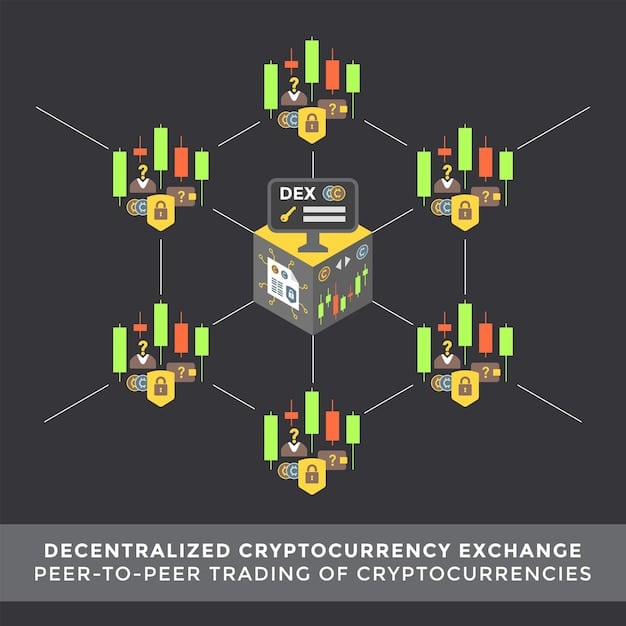Earn 8% APY on Stablecoins: DeFi Strategy for US Investors in 2025

Earning 8% APY on stablecoins in 2025 involves strategic DeFi participation, focusing on platforms offering high yields while considering smart contract risks, impermanent loss, and regulatory changes for US investors.
Want to boost your returns with stablecoins? Discover how to earn an impressive 8% APY through strategic DeFi moves tailored for US investors in 2025. This guide breaks down the methods, risks, and opportunities.
Understanding Stablecoins and APY
Stablecoins are cryptocurrencies designed to maintain a stable value relative to a specific asset, such as the US dollar. This stability makes them attractive for investors looking for a safe haven within the volatile crypto market. APY, or Annual Percentage Yield, represents the actual rate of return earned on an investment over a year, taking into account the effect of compounding interest.
What are Stablecoins?
Stablecoins achieve price stability through various mechanisms, including being pegged to fiat currencies like the US dollar, being collateralized by other cryptocurrencies, or using algorithmic mechanisms to maintain their peg. Understanding the type of stablecoin is crucial as it impacts its stability and potential risks.
How APY Works in DeFi
In the decentralized finance (DeFi) space, APY is often earned by lending, staking, or providing liquidity to decentralized exchanges (DEXs). The APY rates can vary significantly depending on the platform, the demand for the stablecoin, and the associated risks. High APYs usually come with higher risks, so it’s essential to assess these factors before investing.

Stablecoins offer a unique opportunity to earn passive income through DeFi protocols, but it’s crucial to understand how they maintain stability and how APY is generated to make informed investment decisions.
Identifying DeFi Platforms Offering High APY
Finding DeFi platforms that offer high APYs on stablecoins requires thorough research and due diligence. Several platforms compete to attract liquidity, offering attractive rates to users who deposit their stablecoins. However, not all platforms are created equal, and it’s essential to evaluate several factors before committing your funds.
Popular DeFi Platforms for Stablecoins
- Aave and Compound: These are well-established lending and borrowing platforms that allow users to earn interest on their stablecoin deposits. APY rates fluctuate based on supply and demand.
- Curve Finance: This DEX specializes in stablecoin swaps and offers liquidity pools with attractive APYs for users who provide liquidity.
- Yearn.finance: This yield aggregator automates the process of finding the best APYs across different DeFi platforms, optimizing returns for users.
Factors to Consider When Choosing a Platform
When selecting a DeFi platform, consider the following factors: security audits, smart contract risks, impermanent loss potential, platform reputation, and user reviews. A platform with a proven track record and strong security measures is generally a safer option.
Choosing the right DeFi platform for earning high APY on stablecoins involves careful consideration of various factors to mitigate risks and maximize returns.
Strategies for Earning 8% APY on Stablecoins
Earning 8% APY on stablecoins requires employing specific strategies within the DeFi ecosystem. These strategies often involve a combination of lending, staking, and liquidity providing, each with its own set of risks and rewards. US investors need to carefully evaluate these strategies to make informed decisions.
Lending and Borrowing
Lending stablecoins on platforms like Aave and Compound allows users to earn interest from borrowers. The APY is determined by the demand for borrowing the stablecoin. Monitoring these rates and adjusting your strategy can help optimize returns.
Liquidity Providing
Providing liquidity to DEXs like Curve Finance involves depositing stablecoins into liquidity pools. In return, you earn a portion of the trading fees generated by the pool. However, this strategy carries the risk of impermanent loss, which occurs when the price of the deposited assets diverges.

Employing a diversified approach by combining different strategies can help balance risk and optimize returns, potentially achieving the target of 8% APY on stablecoins.
Understanding the Risks Involved
Investing in DeFi comes with inherent risks that US investors need to be aware of. These risks can significantly impact the potential returns and may even lead to loss of funds. Understanding and mitigating these risks is crucial for earning a sustainable 8% APY on stablecoins.
Smart Contract Risks
Smart contracts are the backbone of DeFi platforms, but they are susceptible to bugs and vulnerabilities. A flaw in a smart contract can be exploited by hackers, leading to the loss of deposited funds. Always invest in platforms with audited smart contracts and consider using insurance protocols.
Impermanent Loss
Impermanent loss occurs when providing liquidity to DEXs, and the price of the deposited assets diverges. This can result in a loss of value compared to simply holding the assets. Understanding how impermanent loss works and choosing stable pools can help mitigate this risk.
Regulatory Risks
The regulatory landscape for DeFi is still evolving in the US. Regulatory changes can impact the legality and viability of DeFi platforms and strategies. Staying informed about regulatory developments and consulting with legal professionals is essential.
Mitigating risks involves conducting thorough research, diversifying investments, using insurance protocols, and staying informed about regulatory changes to protect your capital.
Tools and Resources for DeFi Investors
Navigating the DeFi landscape requires access to reliable tools and resources that can help US investors make informed decisions. These tools can assist in tracking APYs, monitoring risks, and staying updated on the latest developments in the DeFi space.
DeFi Portfolio Trackers
- Zapper.fi: This tool allows you to track your DeFi investments across multiple platforms, providing a comprehensive view of your portfolio’s performance.
- DeBank: Similar to Zapper, DeBank offers portfolio tracking, risk assessment, and insights into DeFi projects.
APY Monitoring Websites
Websites like DeFi Pulse and APY.Vision provide real-time data on APYs offered by different DeFi platforms. These resources can help you identify the best opportunities for earning high yields on stablecoins.
Security Audit Reports
Before investing in a DeFi platform, review the security audit reports conducted by reputable firms. These reports highlight potential vulnerabilities in the smart contracts and provide insights into the platform’s security measures.
Leveraging these tools and resources can help US investors navigate the DeFi space more effectively, make informed decisions, and optimize their stablecoin investment strategies.
Future Trends in DeFi and Stablecoins for 2025
The DeFi space is rapidly evolving, and US investors need to stay informed about future trends to capitalize on new opportunities and adapt to changing market conditions. Several trends are expected to shape the DeFi and stablecoin landscape in 2025.
Increased Institutional Adoption
As DeFi matures, more institutional investors are expected to enter the space, bringing significant capital and expertise. This influx of capital can lead to increased liquidity, improved infrastructure, and greater stability in the DeFi market.
Regulatory Clarity
Regulatory clarity is expected to improve in the US, providing a more defined framework for DeFi activities. This can foster greater confidence among investors and encourage further innovation in the space.
Advancements in Stablecoin Technology
Stablecoin technology is continually evolving, with new types of stablecoins emerging that offer improved stability and efficiency. Exploring these new options can provide additional opportunities for earning high APYs.
Staying informed about these trends can help US investors position themselves for success in the evolving DeFi and stablecoin landscape, maximizing their potential for earning 8% APY and beyond.
| Key Point | Brief Description |
|---|---|
| 💰 High APY Platforms | Identifying platforms such as Aave, Compound, and Curve Finance that offer attractive APYs on stablecoins. |
| 🛡️ Risk Mitigation | Understanding and mitigating risks like smart contract vulnerabilities and impermanent loss in DeFi. |
| 📊 DeFi Strategies | Employing strategies like lending, staking, and providing liquidity to reach the 8% APY target. |
| 🌐 Future Trends | Staying updated on institutional adoption, regulatory clarity, and advancements in stablecoin technology. |
FAQ
▼
The main risks include smart contract vulnerabilities, impermanent loss (if used in liquidity pools), regulatory changes, and the risk of the stablecoin losing its peg.
▼
Choose stable pools on DEXs, monitor pool compositions, and consider using insurance protocols that offer protection against impermanent loss.
▼
Aave, Compound, and Curve Finance are popular platforms known for offering competitive APYs on stablecoin deposits through lending and liquidity providing.
▼
Security audits are vital. They identify potential vulnerabilities in smart contracts, reducing the risk of hacks and loss of funds. Always check audit reports before investing.
▼
Keep an eye on increased institutional adoption, regulatory clarity, and advancements in stablecoin technology, which can significantly impact DeFi investment strategies.
Conclusion
Earning 8% APY on stablecoins in 2025 requires a strategic approach to DeFi, focusing on identifying high-yield platforms, understanding and mitigating risks, and staying informed about future trends. By carefully evaluating these factors, US investors can maximize their potential for earning passive income in the DeFi space.





